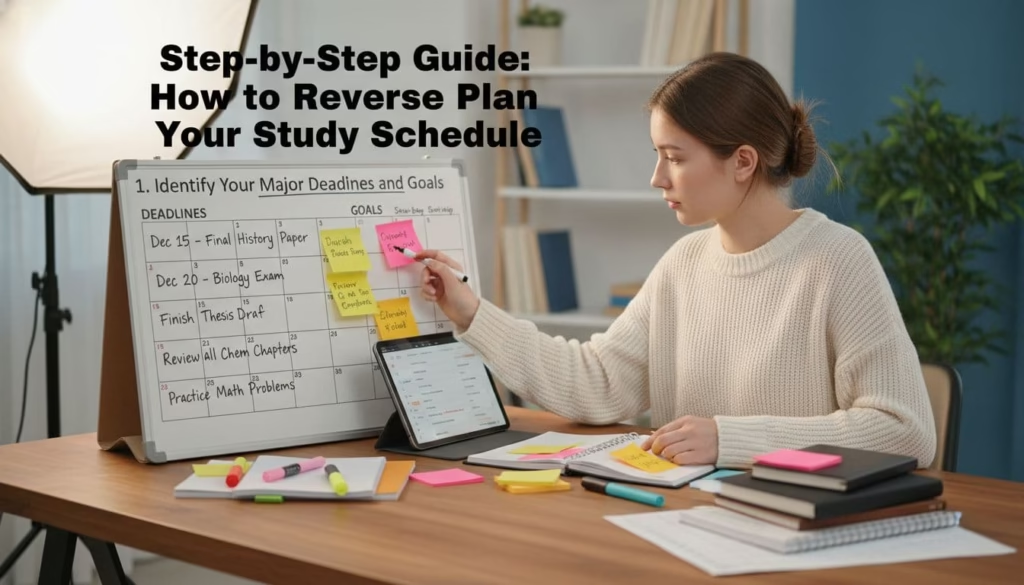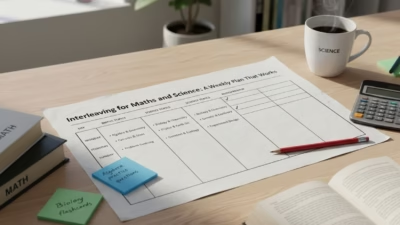Ever felt that sinking panic when exam day sneaks up, and you’re buried under a mountain of last-minute cramming? You’re not alone; many students scramble to catch up, only to end up exhausted and forgetting half of what they’ve read. But what if you could turn that chaos into calm control?
That’s where reverse planning comes in. You start with your end goal, like that big exam date, and work backwards to map out a realistic schedule. It breaks down the prep into daily steps that fit your life, so you cover everything without the rush.
This approach cuts stress big time. In the UK, a Mental Health Foundation survey found that 95% of young people see exams as a top stressor, often leading to burnout. Reverse planning helps by spreading out your work, boosting retention through steady practice, and even lifting your grades with focused effort.
Unlike traditional forward planning, which often leaves gaps and guesswork, this method flips the script for smarter results. You’ll build habits that stick, not just for now but for future goals too.
In this post, we’ll walk through the steps to create your reverse plan, share real tips to make it work, and explore how it tackles common pitfalls. Stick with it, and watch your study game transform. For more on building strong habits, check out effective strategies for exam study.
Key Takeaways
- Reverse planning starts with your exam date, then works back into milestones and daily tasks.
- It reduces stress and improves retention by spreading study over time with built-in reviews.
- Compared with forward planning, it closes gaps, limits procrastination, and keeps tasks tied to outcomes.
- A simple four-step flow works: set end goals, map milestones, assign weekly and daily tasks, then review and adapt.
- Common mistakes include overloading sessions, skipping breaks, and not adapting when plans change.
Table of Contents
- Key Takeaways
- What Is Reverse Planning and Why It Works for Your Studies
- Step-by-Step Guide: How to Reverse Plan Your Study Schedule
- Common Pitfalls in Reverse Planning and How to Avoid Them
- Conclusion
- Frequently Asked Questions About Reverse Planning Study Schedules
What Is Reverse Planning and Why It Works for Your Studies

Reverse planning flips the usual way you set up your study routine. You begin with your final deadline, like an exam date, and count back to break it into small, daily tasks. This backward approach ensures every step points straight to success, unlike forward planning that starts from today and often misses the mark. Picture it like plotting a route on a map: you mark the destination first, then trace the path home. It sharpens your focus, saves time, and lets you adjust for surprises, such as a sudden family trip. Psychologically, it builds confidence too; seeing the goal upfront makes the whole process feel achievable, not overwhelming.
Take a history exam two weeks away. With reverse planning, you list key topics, divide them by days, and slot in review sessions right up to test day. Forward planning might just block out “study time” vaguely, leading to overload or skipped bits. This method ties tasks to real outcomes, so you dodge procrastination by knowing exactly why each session matters.
The Key Differences from Traditional Scheduling
Forward planning kicks off from now and pushes toward a goal, but it can leave you guessing about the details. Reverse planning starts at the end and works back, guaranteeing no loose ends. Here is a quick breakdown of how they stack up:
- Starting Point: Forward begins today with broad ideas; reverse locks in the deadline first and fills in the gaps.
- Task Flow: Forward risks overload if life gets busy; reverse spreads work evenly, building in buffers for rest or changes.
- Procrastination Trap: Forward often delays tough parts since the end feels far off; reverse links every task to the win, keeping you motivated and on track.
For a weekly revision plan on maths topics, forward might say: “Monday: Revise algebra (2 hours).” But if you fall behind, the week unravels. Reverse starts from Friday’s mock test, counts back to assign algebra on Monday, equations Tuesday, and so on, with quick checks daily. You hit the target without the scramble.
Proven Benefits Backed by Study Habits Research
Research from UK education experts shows backward planning boosts grades and cuts stress. A study on implementing backward design in EFL classes found students scored higher by focusing on end goals from the start, much like UK secondary pupils prepping for exams. Another report highlights how this method transforms lessons for better outcomes, as noted by ACER in their piece on backward planning for better learning.
You gain better work-life balance, fitting in hobbies or mates without guilt. Anxiety drops too; no more all-nighters wondering if you covered enough. Imagine a GCSE student facing science mocks. Reverse planning carves out 45-minute slots over weeks, leaving evenings free, so you sleep well and retain more. For A-level history revision, it means targeted essay practice tied to exam questions, easing that knot in your stomach. Overall, it turns study into a steady climb, not a frantic race.
Step-by-Step Guide: How to Reverse Plan Your Study Schedule

Ready to build your own reverse plan? Grab a calendar, notebook, or a free app like Google Calendar or Notion, popular among UK students for their simple setup. Start by noting your big deadline, then fill in the steps below. This process turns vague ideas into a clear path, so you hit your goals without the usual scramble.
Step 1: Set Your Final Goals and Deadlines
Pin down what you want to achieve first. Think specific and measurable, like “master 10 biology chapters by GCSE exam on 15 June.” Adapt SMART goals for studying: make them Specific (what topics?), Measurable (how many pages or problems?), Achievable (fits your week?), Relevant (ties to the exam?), and Time-bound (by when?).
Write your exam date or project due at the top of your page right now. List main goals, such as passing with a grade 7 in maths. Break long-term aims into milestones, like completing unit tests by mid-May. This sharpens your focus from the start. For example, if your A-level history paper looms in two months, aim to outline five key events by week four. Tools like the free planner from BBC Bitesize can help track these.
Step 2: Work Backwards to Create Milestones
From your end date, count back to plot key points. Mark dates for mock tests, topic finishes, or group revisions. Add buffer time, say two days per week, for unexpected delays or extra practice.
Take a month-long plan for French revision. Exam on 30 April: set milestone for full vocabulary review by 25 April, grammar drills by 20 April, and speaking practice by 15 April. Work back from there, spacing sessions to avoid cramming. Use a simple timeline in your notebook:
- 30 April: Exam day.
- 25-29 April: Light revision and rest.
- 20-24 April: Full practice papers.
- 15-19 April: Topic deep dives.
This backward mapping ensures you cover everything, with room for tweaks.
Step 3: Assign Daily and Weekly Tasks
Now fill the gaps with doable blocks. Slot in 45-60 minute sessions around school, meals, and sleep; aim for six hours max per day to stay sharp. Tackle hard subjects early, like equations before lunch when your mind is fresh.
Prioritise based on weak spots, say physics over English if that’s your worry. Try the Pomodoro technique: 25 minutes study, five-minute break, to keep energy up. For a weekly view, block Monday for algebra (two sessions), Tuesday for geometry. Here’s how to break it down:
- Daily: One chapter read, 20 practice questions.
- Weekly: Sunday review of the past six days.
Apps like Forest help block distractions during these slots, making tasks stick.
Step 4: Add Flexibility and Review Points
Life throws curveballs, so build in breaks and wiggle room. Schedule one free day weekly for rest or catch-up, plus extra hours if illness hits.
Set Sunday evenings for check-ins: scan what you covered, adjust next week’s load. Did you finish those notes? Shift them forward if needed. This keeps the plan alive and your spirits high, turning setbacks into small wins. Over time, these reviews build momentum, so you end strong rather than stressed.
Common Pitfalls in Reverse Planning and How to Avoid Them

Ever planned your study sessions only to watch them spiral into chaos? Reverse planning shines when you spot these traps early. Many students pack too much in, skip rest, or freeze when things shift. Spot them now, and your schedule stays solid. Let’s break down the main ones with fixes that keep you on track.
Overloading Your Schedule with Unrealistic Tasks
You start with big ambitions, like covering three chapters in one evening, but life pulls you away. This happens because we underestimate time; a quick skim turns into hours of notes. Draw from past experiences to fix it. Think back to last revision: how long did that essay really take? Add 20% extra for surprises.
Start small to build confidence. Begin with one focused task per slot, say 30 minutes on key terms, then scale up as you see what works. A GCSE student juggling netball might plan two hours for biology but recall games eat into evenings. Adjust to 45 minutes, and you avoid burnout. Track your wins in a journal to refine estimates next time.
Forgetting to Include Breaks and Downtime
Your brain needs pauses to lock in what you learn. Without them, retention drops; simple science shows spaced practice strengthens memory links, much like sleep cements facts overnight. Push through without breaks, and fatigue hits hard, wiping out progress.
Build in rest right away. Slot five-minute stretches every 25 minutes, plus longer downtime for fun. Schedule a walk or chat with friends to recharge. Picture an A-level pupil revising economics: after two sessions, hit the park for 30 minutes. This keeps energy high and turns study into a rhythm you enjoy. For more on why backward planning beats forward slips, see this guide on staying motivated.
Failing to Adapt When Plans Change
Deadlines shift, like a school trip cutting your week short, and panic sets in if your plan feels rigid. But flexibility makes reverse planning strong; treat it as a guide, not a cage.
Revise fast without stress. List tasks, then reshuffle: swap a heavy day for lighter review. Keep a buffer, like one free slot weekly, for tweaks. A history student facing mocks might move essay practice forward by a day. Check in Sundays to spot issues early. This way, changes become chances to refocus, not roadblocks. Stay consistent by celebrating small shifts; you’ll finish stronger.
Conclusion
Reverse planning starts with your end goal and works back to build a clear study schedule. You set deadlines, map milestones, assign daily tasks, and add flexibility to handle changes. Watch out for common slips like packing in too much or skipping breaks; adjust as you go to stay on track.
This method brings real wins. You cut stress, boost retention, and lift your grades without the last-minute panic. Students across the UK swear by it for calmer prep and sharper focus.
Give reverse planning a go for your next exam or project. Grab your calendar today and map it out. Share your results in the comments below; let’s hear how it works for you. Small tweaks like this spark big academic successes, so start now and own your future.
Frequently Asked Questions About Reverse Planning Study Schedules
What is reverse planning for studying?
Reverse planning is a method that starts with your final goal, such as the exam date, then works backwards to create milestones and daily tasks. Each step ties directly to the outcome, which helps you stay focused and avoid guesswork.
How does reverse planning reduce stress and improve results?
It spreads study across weeks, adds buffer time, and builds in regular reviews. This reduces last-minute cramming, supports spaced practice, and helps you retain more. In the UK, most young people report exams as a top stressor, so a steady plan helps mood and performance.
How do I create a reverse study plan?
Use four steps. Set your end goals and deadlines. Map key milestones by counting back from the exam. Assign weekly and daily tasks in short focused sessions. Add weekly reviews and buffer time so you can adjust when life changes.
How is reverse planning different from traditional forward planning?
Forward planning starts from today, which can lead to vague blocks and missed topics. Reverse planning starts from the end goal, then fills the path back with specific tasks and checks. It keeps you on track and reduces procrastination.
What common mistakes should I avoid?
Avoid overloading sessions, skipping breaks, and sticking rigidly to a plan when dates shift. Add buffers, schedule rest, and review progress each week so you can rebalance tasks without panic.




